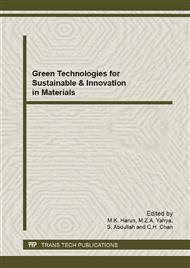[1]
A. Uhlir, Electrolytic shaping of germanium and silicon, The Bell System Technical Journal. 35 (1956) 333-347.
DOI: 10.1002/j.1538-7305.1956.tb02385.x
Google Scholar
[2]
A. Bsiesy and J. C. Vial, Voltage-tunable photo- and electroluminescence of porous silicon, Journal of Luminescence. 70 (1996) 310-319.
DOI: 10.1016/0022-2313(96)00064-6
Google Scholar
[3]
D. F. Timokhov and F. P. Timokhov, Influence of injection level of charge carriers in nanostructured porous silicon on electroluminescence quantum efficiency, Microelectronic Engineering. 81 (2005) 288-292.
DOI: 10.1016/j.mee.2005.03.021
Google Scholar
[4]
D. A. Kim, J. H. Shim, and N. H. Cho, PL and EL features of p-type porous silicon prepared by electrochemical anodic etching, Applied Surface Science. 234 (2004) 256-261.
DOI: 10.1016/j.apsusc.2004.05.028
Google Scholar
[5]
R. Herino, G. Bomchil, K. Barla, C. Bertrand, and J. L. Ginoux, Porosity and pore size distributions of porous silicon layers, Journal of the Electrochemical Society. 134 (1987) 1994-(2000).
DOI: 10.1149/1.2100805
Google Scholar
[6]
R. L. Smith, S. F. Chuang, and S. D. Collins, A theoretical model of the formation morphologies of porous silicon, Journal of Electronic Materials. 17 (1988) 533-541.
DOI: 10.1007/bf02652104
Google Scholar
[7]
R. L. Smith and S. D. Collins, Porous silicon formation mechanisms, Journal of Applied Physics. 71 (1992) R1-R22.
DOI: 10.1063/1.350839
Google Scholar
[8]
L. T. Canham, Silicon quantum wire array fabrication by electrochemical and chemical dissolution of wafers, Appl. Phys. Lett. . 57 (1990) 1046-1048.
DOI: 10.1063/1.103561
Google Scholar
[9]
G. C. John and V. A. Singh, Theory of the photoluminescence spectra of porous silicon, Physical Review B. 50 (1994) 5329-5334.
DOI: 10.1103/physrevb.50.5329
Google Scholar
[10]
L. Jia, S. L. Zang, S. P. Wong, and e. al., Further evidence for the quantum confined electrochemistry model of the formation mechanism of p—type porous silicon, Applied Physics Letters. 69 (1996) 3399-3401.
DOI: 10.1063/1.117272
Google Scholar
[11]
V. Lehmann and U. Gosele, Porous silicon: quantum sponge structures grown via a self-adjusting etching process, Advanced Materials. 4 (1992) 114-116.
DOI: 10.1002/adma.19920040212
Google Scholar
[12]
M. Ohmukai, M. Taniguchi, and Y. Tsutsumi, Large current density and anodization time needed for strong photoluminescence in porous silicon, Material Science and Engineering B. 86 (2001) 26-28.
DOI: 10.1016/s0921-5107(01)00635-3
Google Scholar
[13]
K. Molnar, T. Mohacsy, M. Adam, and I. Barsony, Porous silicon light-emitting diodes - mechanism in the operation, Optical Materials. 17 (2001) 111-116.
Google Scholar
[14]
V. Paillard, P. Puech, M. A. Laguna, R. Carles, B. Kohn, and F. Huisken, Improved one-phonon confinement model for an accurate size determination of silicon nanocrystals, Journal of Applied Physics Letters. 86 (1999) 1921-(1924).
DOI: 10.1063/1.370988
Google Scholar
[15]
Z. Sui, P. P. Leong, I. P. Herman, G. S. Higashi, and H. Temkin, Raman analysis of light-emitting porous silicon, Applied Physics Letters. 60 (1992) 2086-(2088).
DOI: 10.1063/1.107097
Google Scholar
[16]
I. H. Campbell and P. M. Fauchet, The effects of microcrystal size and shape on the one phonon Raman spectra of crystalline semiconductors, Solid State Communications. 58 (1986) 739-741.
DOI: 10.1016/0038-1098(86)90513-2
Google Scholar
[17]
O. Ben Younes, M. Oueslati, and B. Bessaı̈s, Anodisation-related structural variations of porous silicon nanostructures investigated by photoluminescence and Raman spectroscopy, Applied Surface Science. 206 (2003) 37-45.
DOI: 10.1016/s0169-4332(02)00800-0
Google Scholar
[18]
A. K. Sood, K. Jayaram, and D. V. S. Muthu, Raman and high-pressure photoluminescence studies on porous silicon, Journal of Applied Physics. 72 (1992) 4963-4965.
DOI: 10.1063/1.352066
Google Scholar
[19]
E. Savir, J. Jedrzejewski, A. Many, Y. Goldstein, S. Z. Weisz, M. Gomez, L. F. Fonseca, and O. Resto, Relation between electroluminescence and photoluminescence in porous silicon, Materials Science and Engineering: B. 72 (2000) 138-141.
DOI: 10.1016/s0921-5107(99)00488-2
Google Scholar
[20]
C. Meyer, H. Lorenz, and K. Karrai, Electroluminescence from a current-emitting nanostructured silicon device, Superlattices and Microstructures. 33 (2003) 339-346.
DOI: 10.1016/j.spmi.2004.02.008
Google Scholar


